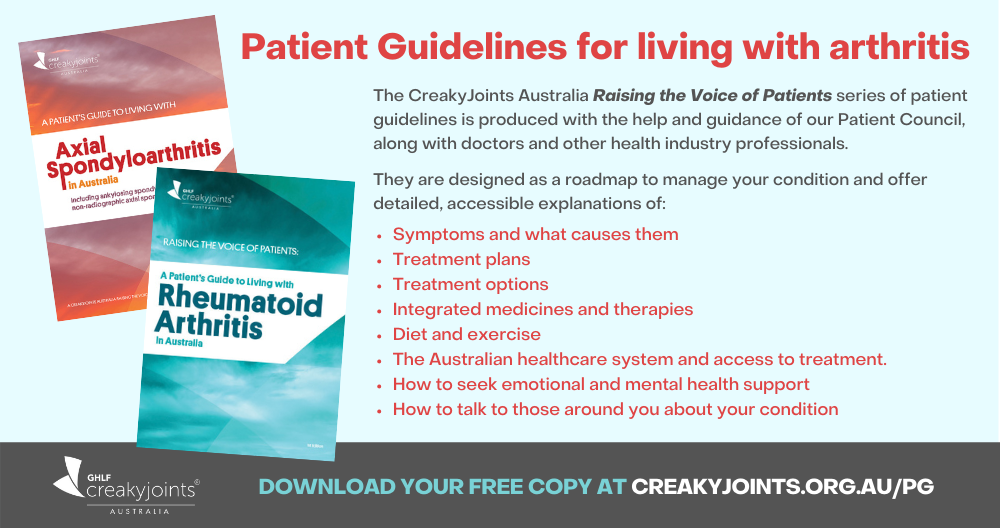10 Things to do After an Arthritis Diagnosis: Top Tips From Patients
You’ve just found out you have arthritis. Now you need to know how to live with it.
These practical tips will help you get started.


There are over 100 forms of arthritis including osteoarthritis, rheumatoid arthritis, psoriatic arthritis, ankylosing spondylitis and many more. It can affect people of all ages, yet most of us have similar fears and questions after we’re diagnosed.
All the tips on this page were drawn from the publications in the CreakyJoints Australia Raising the Voice of Patients series of patient guidelines.
Our patient guidelines offer detailed, accessible explanations of symptoms and what causes them, treatment plans, treatment options, integrated medicines and therapies, diet and exercise, as well as how to talk to family and friends about these conditions and how they impact a person’s life.
The following patient guidelines are available as free downloads from our website:
➤ A Patient’s Guide to Living with Rheumatoid Arthritis in Australia
The CreakyJoints Australia team members all live with arthritis and we’ve picked out ten of our favourite tips to help you learn to manage your condition well.
1. Be Your Own Healthcare Advocate
Living with arthritis is challenging. Pain and fatigue can take a major toll on our wellbeing and our sense of self. Our journey with arthritis is made much harder when we have to fight for understanding — from our doctors, friends, colleagues and peers.
CreakyJoints Australia has developed a Patient Charter to clearly outline what we need from the healthcare system and the kind of treatment we deserve and expect. It outlines the guiding principles and deeply held beliefs that drive our community’s ongoing efforts to improve patient care for people living with arthritis, as well as their families and loved ones.
Ultimately, you are your best advocate. It is important to empower yourself to support your overall health through a healthy lifestyle and make sure your voice is heard with all your doctors so the best treatment plan can be put in place. You can also seek a second opinion if you feel like you are not being heard.
2. Pick the Best Healthcare Team for You
Actively choosing your own team will help you gain a better understanding of your condition, assess which treatments are right for you and help you manage your health more effectively. It also helps you to have a sense of control over your condition rather than the other way around.
Your team starts with you. Your closest team members will generally be your family, friends, general practitioner (GP) and rheumatologist. Depending on your needs, it may also include people like allied health practitioners, surgeons, pharmacists, pathology nurses or others.
Before selecting any health professionals for your team, it is important that you ask how much experience they have had treating your condition. As with all professionals, some are more experienced and more helpful than others so you may need to see a few to find the best one for you.
It’s a good idea to create a shortlist of practitioners you are considering for various roles in your team. Contact them or check their website to see if they are members of professional associations and if they have experience treating people with similar types of arthritis to you.
Your GP will have lists of many other healthcare providers in your area. They will consider your needs and circumstances and refer you to the appropriate specialists. You can also ask people you trust such as a family member, friend or someone in your support group for their recommendations. Keep in mind that we are all different and just because a provider is a good fit for someone else doesn’t mean they will always be right for you.
3. Learn to Ask Questions About Treatments
While your doctor prescribes your medications, you are a full partner in any decisions about your treatment options. The best way to be an active participant in your treatment is to be informed. Start writing a list of your questions as you think of them and remember to take your list to your appointments.
Some of the questions we suggest include:
➤ How will your condition likely progress and what might you do to help keep track of your symptoms and experiences?
➤ Are there any types of physical therapies, exercises, diets or complementary treatments your doctor would or wouldn’t recommend for you?
➤ What are the short and long-term goals of recommended treatments?
➤ Is there an optimal time to take your medication? What happens if you miss a dose?
➤ How soon after starting your medication should you expect to begin feeling better?
➤ What relevant support services (including mental health services) and groups are available in your community and online?
4. Find Ways to Talk to Others About Your Arthritis
When you have arthritis, you may not always look like you’re sick or in pain on the outside. People around you may not realise you hurt, that your joints are stiff or hard to move or that you’re so tired you could sleep for 20 hours and wake up still tired. They don’t understand what it’s like to manage the pain associated with conditions like yours.
It is also important to remember your loved ones are on this journey too. Your diagnosis and all the information that comes with it can be as overwhelming for your loved ones as it is for you.
Encourage them to talk about how your disease affects them and look for ways to manage it together. Sharing information about your condition and treatment with those around you may help them to understand and to learn the best ways to help you.
5. Reach Out for Support
It is understandable to experience feelings of sadness, grief, anxiety or depression at various times, especially if you aren’t getting the support you need from those around you.
It’s ok to reach out to mental healthcare professionals when you need to. You might find that a counsellor or psychologist ends up as a valuable member of your healthcare team. Talk to your GP first as they can help you and refer you to a subsidised support program if needed.
Peer support groups are full of people going through similar challenges as you. They are a place where people with similar conditions can connect and share information, experiences and coping tips.
Support groups can be categorised not only by who runs them but also where and how they are run. Groups can be run by health professionals, community groups or individuals. They can be conducted in person, over the phone or online via social media and video conferencing platforms.
Support groups are not ‘one size fits all’. Take your time and explore your options. Contact groups that interest you and ask questions about how they are run. You can even ask to join a few meetings to see if they fit your needs. For online groups, observe the types of posts and comments that come up for a while before you decide if you want to participate in discussions.
You’ll know when you’ve found the right group when you start to feel you are part of their community. Give it a go and you won’t need to feel you are alone in your struggles anymore.
6. Learn About the Risks of Not Treating Your Arthritis
Many people are hesitant to take medications for their arthritis at first. This is understandable as we are often fearful of the risks (real or perceived) or side-effects that can come from taking them.
One risk that sometimes gets overlooked is the risk of not taking evidence-based medication to control or stop the progression of arthritis, especially autoimmune arthritis (forms of arthritis that occur when the immune system overreacts to a trigger, such as a virus, and starts to attack healthy joints).
Rheumatoid arthritis and ankylosing spondylitis, for example, are serious diseases that can affect many parts of the body and lead to a reduced life expectancy. If conditions like these are allowed to progress unimpeded (either by choice or through delayed diagnosis), significant joint damage can occur in as little as two years. The resulting deformities can be extremely painful and debilitating and seriously impact your quality of life. Uncontrolled autoimmune arthritis can also increase the likelihood of developing other severe health issues such as heart problems.
Osteoarthritis (the most common form of arthritis) occurs when the protective cartilage that cushions the ends of your bones wears down over time. It is typically associated with older adults but can occur at any age. Medications used to treat osteoarthritis (OA) mainly reduce your pain.
It is also a good idea to weigh up the potential risks of taking medication against the benefits you stand to gain from them. For example, the reduction in pain and inflammation from taking appropriate medication often results in increased energy and improved physical function. That could mean playing your favourite sports again, socialising more with your friends and family or increasing your job options.
Above all, keep an open mind and be prepared to try things out to see what happens.
7. Find Out How Arthritis Medical Treatments Work
There is no magic pill to fix arthritis, as every patient responds to treatments differently. There are lots of options and combinations of treatment approaches that can help you, so the trick is to be positive and patient while you discover what works best for you. It is important to work with your treating doctor (usually a rheumatologist), tell them how you feel and take your medicines as prescribed so they know what is or isn’t working.
Arthritis treatments can include both medicinal and non-medicinal treatments. The type of arthritis you have will determine the types of medication most likely to help your symptoms improve. For example, osteoarthritis is usually managed with pain killers and nonsteroidal anti-inflammatory drugs (NSAIDs) whereas many forms of autoimmune arthritis also respond well to disease-modifying antirheumatic drugs (DMARDs). DMARDs also help to slow disease progression and reduce the likelihood of joint damage.
It’s important to take a holistic approach when treating arthritis, which means having different tools, in addition to medication, which can help with different areas of the body. Although medicines have an extremely important part to play in treating your condition, there are lots of other things you can do to help fight symptoms and keep your body in the best health possible.
8. Do Your Homework on Non-Medicinal Treatments
Non-medicinal treatments include diet and nutritional approaches, therapeutic exercise (planned physical movements or activities designed to prevent or manage problems with body structures and functions) and complementary therapies. Discuss these and other treatments you want to try with your healthcare team, so you can develop a comprehensive approach to achieving optimum health.
Therapeutic exercise is highly beneficial for people with arthritis as it helps you to improve or maintain your joint functionality and range of motion, muscle strength, tone and flexibility, cardiovascular health, mental health and much more. Your doctor may be able to recommend suitable classes or therapeutic exercise practitioners in your area.
Complementary therapies are those that can usually be safely used alongside conventional pharmaceutical therapies and exercise, although we recommend you get your treating doctor’s approval before you begin them. There are many complementary therapies that can help you manage your arthritis symptoms. They include acupuncture, massage therapy and relaxation/mindfulness. Once again, it’s a good idea to keep an open mind and be prepared to try things out.
Some people with arthritis also feel better or have symptom relief with specific diets or dietary supplements. A lot can depend on the quality of ingredients and the dosage needed to make them effective. While research is mixed on the effectiveness of most diets and dietary supplements for arthritis symptoms, some may show promise. You may find these therapies helpful as a part of your overall treatment plan, but they won’t be a magic cure for your symptoms or automatically allow you to stop taking your medications.
9. Get the Facts on Dealing With Infections
If you have a cold or upper respiratory infection and you are on a DMARD for autoimmune arthritis, it’s important to see your doctor as soon as possible. While viral infections cannot be treated with antibiotics, if you develop a bacterial infection, you may need to start antibiotics quickly to reduce the spread of the infection.
Your doctor will help you weigh up the risks of continuing on your DMARD medication (and therefore making it harder for your body to fight the infection) or reducing, skipping or ceasing your medication until your infection clears (and therefore increasing the likelihood that your symptoms will worsen). There is no fixed formula here. Your doctor will need to make a judgement call as to which avenue is most appropriate for you at the time.
10. Learn About the Government Supports You Can Access
Many people think that, if they are working or their partner’s income is too high, they won’t qualify for any pensions or benefits from the Australian Government. Unfortunately, many health professionals don’t have time to tell their patients about available supports during appointments either. As a result, people with arthritis often miss out on supports that can help them immensely.
The CreakyJoints Australia team have put together extensive lists of both government and community resources that many of us can access. These include:
➤ The Chronic Disease Management Plan
➤ The GP Mental Health Treatment Plan
➤ The National Disability Support Scheme (NDIS)
➤ The Mobility Allowance
➤ Occupational therapy programs, and much more.
This information should never replace the information and advice from your treating doctors. It is meant to inform the discussion that you have with healthcare professionals, as well as others who play a role in your care and well-being.






